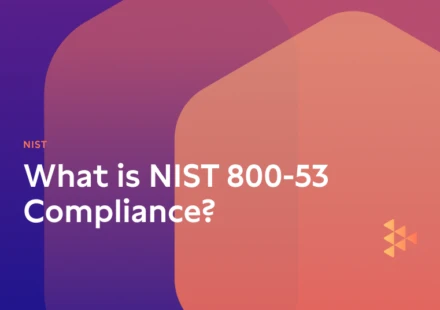NIST 800-53, Security and Privacy Controls for Information Systems and Organizations, is a special publication of the NIST Cybersecurity Framework (NIST CSF). This version of the NIST framework is based on a set of security controls and guidelines published by the National Institute of Standards and Technology (NIST).
NIST 800-53 compliance is mandatory for any federal agency, contractor, or operation that works with the government under the Federal Information Security Modernization Act (FISMA). The guidelines set out by NIST 800-53 are designed to help protect the confidentiality, integrity, and availability (CIA Triad) of sensitive information and ensure that it is used in a manner consistent with NIST’s mission and objectives.
Why NIST 800-53 Compliance is Essential for Securing Federal Data
First and foremost, NIST 800-53 provides a comprehensive framework for federal agencies to follow when securing their systems. This helps to ensure that not only government organizations are secure, but the third parties and vendors they engage are also prioritizing security and privacy.
Furthermore, organizations that leverage NIST 800-53 are not only more likely to also achieve compliance with various information security laws and regulations, but will benefit from regular updates that reflect the continuously evolving threat and cybersecurity landscapes. The framework is designed so that as new security systems, technologies, and innovations develop, those who are compliant with NIST 800-53 can continue to meet their shifting cybersecurity needs.
Finally, NIST 800-53 provides a common language and set of standards. Federal organizations are able to communicate more effectively about their security programs with each other and with key stakeholders, including contractors and vendors.
What are NIST 800-53’s Controls?
NIST 800-53 controls were developed to be adaptable and customizable regardless of your organization’s size. These controls were designed to help protect an organization’s sensitive information from a variety of threats – from accidental human error to malicious attacks by bad actors.
The standard’s 1000+ security controls are organized into 20 families:
| ID | Family | ID | Family |
|---|---|---|---|
| AC | Access Control | PE | Physical and Environemnt Protection |
| AT | Awareness and Training | PL | Planning |
| AU | Audit and Accountability | PM | Program Management |
| CA | Assessment, Authorization, and Monitoring | PS | Personnel Security |
| CM | Configuration Management | PT | PII Processing and Transparency |
| CP | Contingency Planning | RA | Risk Assessment |
| IA | Identification and Authorization | SA | System and Services Acquisition |
| IR | Incident Response | SC | System and Communications Protection |
| MA | Management | SI | System and Information Integrity |
| MP | Media Protection | SR | Supply Chain Risk Management |
Note: 17 of the 20 control families align with the security requirements outlined in FIPS 200.
The use of NIST 800-53 controls can be broken down into three phases:
- Choosing and implementing the security and privacy controls that meet your business’s unique needs.
- Assessing how effective the implementation of said controls is and operationalizing the controls and their processes throughout your organization to build a comprehensive security system.
- Continuously monitoring and improving upon the resulting information security system.
Why is it important to comply with NIST 800-53?
Complying with NIST 800-53 is often a requirement for organizations that handle sensitive government information. For those that are required to be compliant, failure to do so can result in significant legal and financial consequences.
But even if a company is not mandated to achieve NIST 800-53 compliance, implementing the standard’s controls sets a great security foundation and enables businesses to protect themselves against a variety of security threats, including cyber attacks, unauthorized access, and data breaches.
How to comply with NIST 800-53
Complying with NIST 800-53 involves implementing a set of security controls and ongoing monitoring and assessment of your organization’s information systems. Here are the key steps to take to achieve NIST 800-53 compliance:
- Understand the requirements of NIST 800-53: Before implementing any security controls, it’s important to understand their requirements, specifically what each control’s base control and control enhancement require of you. This will help you determine which controls are relevant to your organization and how to implement them efficiently and effectively.
- Develop a plan for implementing NIST 800-53: Once you have a good understanding of the requirements of the NIST 800-53 control family that best suits your organization, you can develop a plan for implementing the relevant base control and control enhancement. This plan should outline the specific controls you will implement, who will be responsible for implementing them, and how they will be implemented.
- Implement the security controls: The next step is to implement the security controls outlined in your plan. This may involve updating your organization’s information systems, training employees on security best practices, and implementing access controls and other security measures.
- Ongoing monitoring and assessment: Implementing security controls is not a one-time event – it’s an ongoing process. In order to ensure that your organization remains compliant with NIST 800-53, you should regularly monitor and assess your information systems to identify any potential vulnerabilities or weaknesses.
Ready for more support in your journey to becoming NIST 800-53 compliant?
With the Carbide Platform, services, and dedicated team of security experts, you can easily get started with implementing the relevant security controls, continuous monitoring to assess your information systems on an ongoing basis, and doing what it takes to prove you meet NIST 800-53’s requirements for security and privacy. Start your free trial today.

